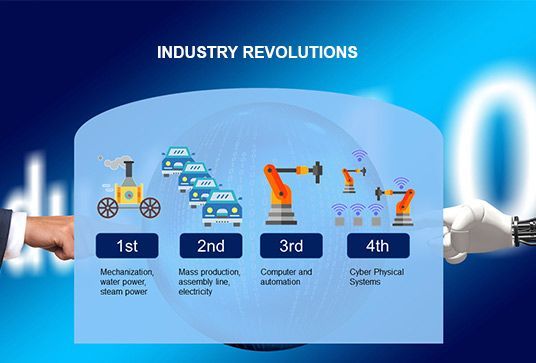Industry 4.0: The Fourth Industrial Revolution, improving Safety and Quality in the Factory

Industry 4.0
With the advent of digitilization, industries are becoming more competitive and offer personalized products and services. The industry of the future is moving towards an interconnected global system. Permanent communication between machines and systems (ERP, etc) guarantees an increasing improvement in production.
How to meet the requirements in industrial production
At the end of the 1980’s, food processors needed an electronic device to control 2 main parameters: time and temperature. The answer to this request was a PLC, which task was only to manage cycles. A few years later, more parameter requests were added to the PLCs: F0 value management, flexible packaging’s distortion, cycle reports, network connection, retort line management and finally, integration in a whole production line in order that the processor could manage everything from a single interface.
New technologies that were being released on the market were actually adapted. The only objective was to improve and better control the thermal treatment. Based on this experience, retort manufacturers are now preparing the future: big data management and smart industry. Current developments are based on 5 main directions: maintenance and calibration, quality and traceability, energy consumption, monitoring and control, cybersecurity. The objective is not only to improve user experience; this is about dramatically improving the fragile balance between product safety and quality.
What are the risks faced by manufacturers with the deployment of Industry 4.0?
The sensitization of manufacturers as to the risks involved in digitizing their production process is important. Cyber attacks can jeopardize a company. All businesses in any industry can be attacked. The first is an attack by cyber attackers trying to recover confidential information. Cyber attacks can destroy a system. Attempts to sabotage with viruses lead to malfunctions and sometimes even a machine breakdown. Ransomware or Distributed Denial of Service (DDOS) campaigns to make a server, service, or infrastructure unavailable may be responsible for downsizing complete manufacturing chains. The machine controlling systems can be rendered unavailable.
How to protect yourself from cyberattacks?
It is essential to put a cybersecurity strategy in place. Performing a monitoring, making a potential risk audit, mapping the systems in place as well as listing the access rights of employees and subcontractors is mandatory. On a more technical level, it is important to protect the computer system with the deployment of Firewalls. It is best to have your IT activity monitored by a specialized organization such as a Security Operations Center (SOC) to be alerted of any incident or attack.
Digitization allows the evolution of production processes
RFID, Artificial Intelligence, Augmented Reality and Data Analysis, all these new technologies offer greater storage capabilities with higher computing power at lower cost.By modernizing, automating and digitizing processes, the place of the person in the chain has evolved. Man no longer produces but accompanies and makes it possible to make the industrial process work. His interventions are diverse and require versatility for setting up and controlling machines. Digitization is a help with process traceability. Maintenance tasks are easier, it is easier and faster to find the cause of failure.
Want to know more about the industry of the future and Steriflow? Join us on Wednesday, February 27, 2019 at a conference “How digitalization improves the heat treatment process” at IFTPS 2019. Speech of Pierrick Salvy at the annual meeting of heat treatment professionals in San Antonio , Texas, USA.
